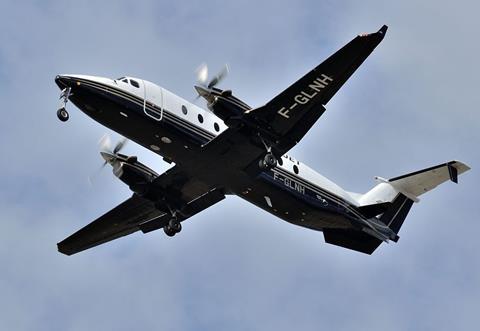French investigators believe heavy rain seeping into a Beech 1900D’s fuselage before take-off, and then freezing during climb, caused pitch control and trim problems during a flight from Toulouse to Metz.
While the potential for such an issue had been known for some 40 years, the crew was “not aware” of a safety communique dating back to 1981, owing to its age, says investigation authority BEA.
The aircraft – operated by regional carrier Twin Jet – had experienced a prolonged downpour prior to departure on 10 December 2021.
BEA says this probably resulted in high humidity in the unpressurised and unheated parts of the fuselage.
As the 1900D climbed towards its cruise altitude of 22,000ft it passed through humid and cold air, and this might have led to ice formation at different points in the vicinity of elevator control and trim cables.
“This could have interfered with the proper functioning of the [elevator or pitch trim] by causing significant friction or even blockages,” says BEA.

After passing 20,000ft the pilots were alerted to an autopilot trim failure. The first officer disengaged the autopilot – which caused the aircraft to pitch steeply nose-up and climb 500ft – and the pilots found the elevator and trim wheel required abnormally large forces.
The crew adjusted throttle and attitude, and determined a trim position which would maintain level flight, controlling the aircraft manually with a mix of engine and flight-control inputs which would avoid forcing the mechanisms.
BEA says that the flight continued to Metz and, as the aircraft descended, warmer air probably melted the ice. The aircraft conducted an ILS approach to runway 22 and, during the flare, the first officer observed that elevator control had returned to normal.
None of the seven passengers and three crew members was injured, and the aircraft (F-GLNH) was undamaged.
BEA has recommended updating crew training on the 1900D give that pilots and operators “probably do not know of the existence” of the May 1981 communique which addressed elevator trim freezing after rain or high-pressure washing.
It also points out that previous risk-mitigating solutions drawn up by the aircraft manufacturer, while reducing the frequency of occurrences, has not led them to “disappear”. BEA is recommending that the US FAA reviews flight-control jamming incidents, relating to ice, on 1900Ds and ensure Textron Aviation proposes corrective measures.


























